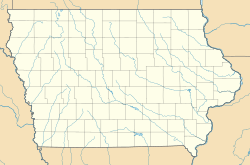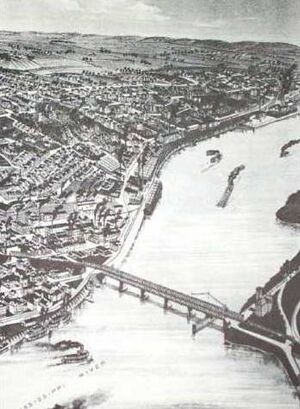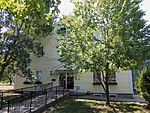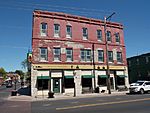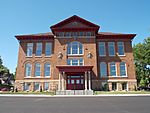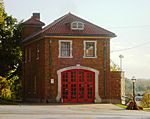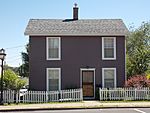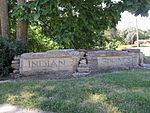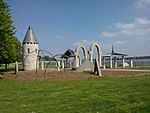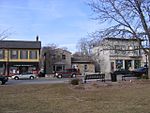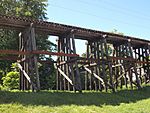Village of East Davenport facts for kids
Quick facts for kids |
|
|
Davenport Village
|
|
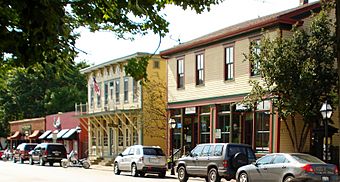
One of Davenport's oldest neighborhoods, the Village of East Davenport is full of small specialty shops and was used as parade grounds for Civil War soldiers from Camp McClellan
|
|
| Location | Roughly bounded by the Mississippi River, Spring, Judson, and 13th Sts., Kirkwood Boulevard, and Jersey Ridge Rd., Davenport, Iowa |
|---|---|
| Area | 72 acres (29 ha) |
| Architect | Multiple |
| NRHP reference No. | 80001459 |
| Added to NRHP | March 17, 1980 |
The Village of East Davenport, also known as The Village, is a special old neighborhood in Davenport, Iowa. It's located right next to the mighty Mississippi River. This area is so important that it was added to the National Register of Historic Places in 1980. It's known for its many historic buildings.
The Village was once its own small town. But after just five years, it became part of the city of Davenport. Today, it's a popular spot for shopping, eating, and having fun. Many of its original buildings from the 1800s are still standing.
Contents
A Look Back in Time
How The Village Started
In 1851, two men named William H. Hildreth and Dr. G.W. Witherwax planned a new town. They called it Upper Davenport. Later, it became known as East Davenport. This area was a wide valley near a bend in the Mississippi River. River travelers knew it as "Stubb's Eddy." This was named after a man named James R. Stubbs. He lived in a cave nearby. The small town was planned to be ten blocks big. By 1856, it had officially joined the city of Davenport.
Early Businesses and Railroads
The first big business in the new town was a sawmill. It used steam power and was started by Robert Christie in 1851. In the 1860s, it became known as Lindsay & Phelps. Another mill, Renwick & Sons, opened in 1854. Logs were floated down the river from northern forests. These mills then processed the wood.
In 1856, the first railroad bridge was built across the Mississippi River. It was just south of The Village. This railroad was very important. It helped move lumber from the mills to new settlements out west. Later, in 1874, another railroad built a wooden bridge on the west side of The Village. This bridge is still there today.
The Civil War Years
Davenport became home to five army camps during the American Civil War. Camp McClellan was the biggest camp. It was set up in 1861. As the war got bigger, the camp also became a hospital. It was also a place where about 300 members of a Sioux tribe stayed. They were involved in events in Minnesota. President Abraham Lincoln later allowed them to be released. They were then sent to reservations in the West.
The Great Fire of 1901
On July 24, 1901, a very big fire happened in The Village. It was one of the worst fires in Davenport's history. The area had many wood buildings and piles of lumber. There were also oil storage tanks nearby. The fire started at the Rock Island Fuel Company. It spread very quickly.
The fire was so hot that it bent the railroad tracks. It also buckled the streets. The smoke was so thick it made the area as dark as night. Flames shot 300 feet into the air. The intense heat created a strong wind. This wind pulled lumber into the air. This helped spread the fire even more. The fire moved towards the downtown area. But it stopped at a hill where a girls' school was located. In the end, 20 acres of land were burned. About 250 people lost their homes. Businesses lost a lot of money, about $1.25 million.
Prohibition Era Events
The Village was also the scene of an event during Prohibition in 1928. Prohibition was a time when making and selling alcoholic drinks was illegal. Federal and local police officers raided the East Davenport Turner's Hall. They found many bottles of homemade drinks. They also found materials used to make them.
The Village Today
Today, the Village of East Davenport still has many of its original buildings. These buildings date from 1848 to 1910. They now house many fun places. You can find specialty shops, restaurants, and other businesses here.
The old Turner's Hall is now a theater. The former Hose Station No. 4 is on 11th Street. It has been turned into the International Fire Museum. This building was added to the Davenport Register of Historic Properties in 1993. The entire Village was placed on the National Register of Historic Places in 1980. Other nearby historic places include the former Pierce School No. 13, Lindsay Park, and Indian Springs Park.
Gallery


